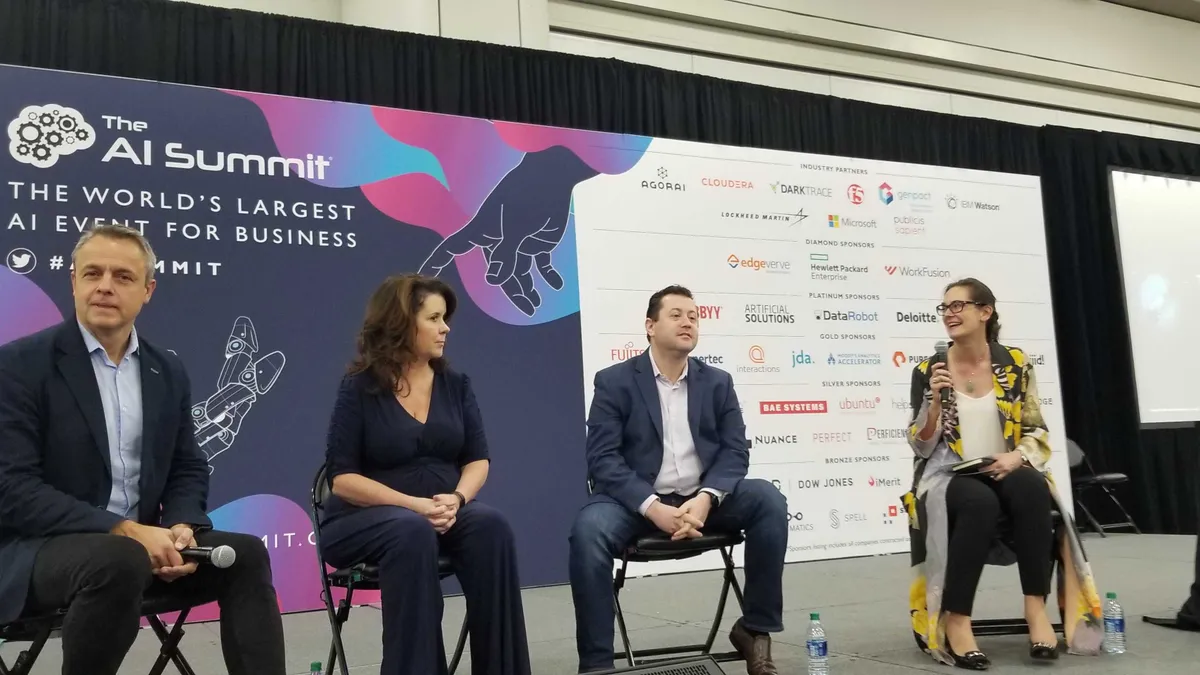NEW YORK — Driven by a desire to boost efficiency, a manufacturing customer once tapped General Electric subsidiary GE Digital to infuse its facilities and supply chain with artificial intelligence.
Involved in the existing tech stack was a cloud computing provider. But as GE entered the design stage of the project, it ran across a barrier: The cloud company wanted to be the one to extract data from the manufacturing equipment, saying its methods were faster than GE's.
"We argued for three months over that," said Rachel Trombetta, principal enterprise architect of GE Digital, speaking on a panel at The AI Summit in New York Wednesday. "And during that time we were not able to provide any value."
Stepping back and allowing GE to take point on the data extraction element of the project, while the cloud provider focused on the supply chain side, would have been a more collaborative approach to the project, Trombetta said.
To navigate the complexities of AI at the enterprise level, companies stand to benefit from taking an ecosystem approach to AI deployment, one which leverages industry strengths and seeks cooperation between multiple stakeholders. In this framework, customer needs shape the priorities of the parties involved.
Given the talent deficit in the AI field — as well as tech as a whole — there's often "not enough people" to deploy large-scale projects, which further marks the need for an ecosystem approach, Trombetta said.
Strength in numbers
Though AI deployment is a complex endeavor, its potential lures even the most conservative industries.
Precisely because of its complexity, AI is the ideal space for an ecosystem environment that steps past individual limitations, according to Gauthier Vasseur, executive director of the Fisher Center for Business Analytics at the University of California, Berkeley, speaking on the panel.
"In an AI project, everything is thrown at us at the same time," Vasseur said. "Our firepower to look at problems holistically is limited if we're by ourselves. It's the ultimate partnership playground."
As talks and panels unfolded at The AI Summit, dozens of vendors pitched their platforms on a crowded showroom.
Seeing clearly where the highest value lies in the swarm of platforms and products the market can offer is "the most challenging job of the 21st century," said Igor Taber, SVP of corporate development and strategy at DataRobot.
"Industry doesn't make it easy to figure out what's what," said Taber. In that context, partnerships can ease the burden of understanding which providers to select.
In certain cases, though, the roles are reversed: AI and machine learning platforms can help companies determine which vendors to select, based on who can provide the products that most closely align with business needs and strategies.
How to get there
Stepping past individual priorities and ceding ground on projects can be an uphill battle given tech's cut-throat competitiveness.
But larger rewards can await providers who adhere to an ecosystem framework. In the case of GE, a $3 million dollar project became a $5 million one after additional partners were brought in to address the needs of an Australian mining company.
Deloitte, one of the partners, had an existing business relationship with the client. GE was brought into the fold because of its industrial expertise and the AI that capabilities it could deploy at that layer.
"One of the things we suffered with was everyone wanted access to the data to prove their hypothesis first," Trombetta said. A valuable step was to collect the data and normalize it for its joint use across the project.
The result was a system that allowed the company to move minerals from a mining facility through manufacturing and to a nearby port on the day the mineral's price would be most beneficial.
Identifying ideal use cases for a partnership requires a customer-first approach. Though it may sound trite, customer interest isn't always the main driver for partnerships, Taber said.
"Taking AI for AI's sake is the first mistake we will do," said Vasseur. If stakeholders within a partnership lose sight of why AI is being deployed "then you'll be in big trouble."















